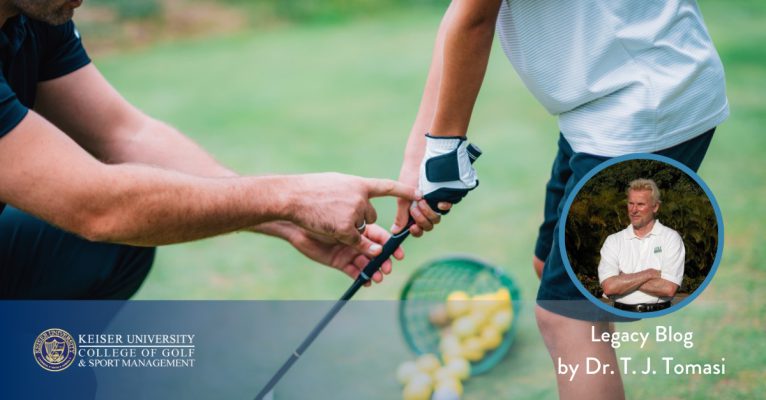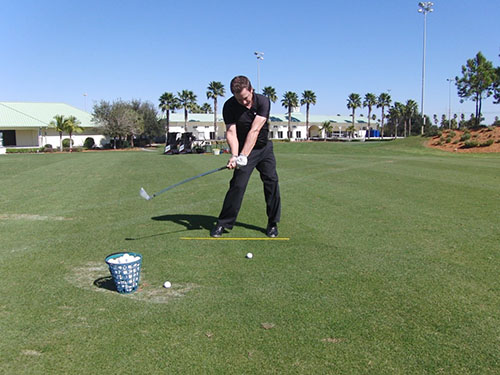Wristy Business: Wrist Action in Your Golf Swing

by Dr. T.J. Tomasi A Legacy Post by Keiser University College of Golf Senior Faculty and Director of Research (1940-2023)
Theme: The release is misunderstood because it has three parts that must be coordinated – they are: (1) wrist action (2) body action and (3) forearm action, all of which, when done correctly, combine to square the clubface to the ball. When any or all of these are absent or out-of-whack, the release is faulty, and the shot goes haywire. This article deals with wrist action. The wrist/hand has 27 degrees of freedom, and it is an architectural masterpiece as far as movement goes. But this incredible array of motions must be controlled to swing correctly, which is why every good golf teacher has hand/wrist control techniques in their teaching arsenal. If your student cannot control their hands, they can’t control the clubface, and this means they can’t control the golf ball.
Wrist Action
Much attention is paid to the lead wrist, an area that can be the source of problems since it is one of the weakest joints in the golf body. Any rogue force applied by the trail hand will buckle the lead wrist, causing the clubface to spin out of control. Thus, all good players have found ways to control the trail wrist. Look at the photo below of the hands as they pass over the rear foot. Here the palm of the trail hand looks at the sky with its knuckles to the ground.

This pro looks ‘late,’ but if there is any single position that the good player gets into, it is this trail-knuckles-to-the-ground position. I estimate that only 2 % of golfers routinely produce this position. Note the trail wrist has a slight cup, and even though it’s almost impact time, a restraining strategy has been learned that will protect the lead wrist from buckling. The strategy is that instead of trying to keep the lead wrist straight, seal the trail wrist.
The Seal of the Trail Wrist
To prevent a sloppy impact, your lead wrist must stay in line with your forearm. If there is any premature pressure exerted on it by the trail hand, your lead wrist will collapse, thereby spinning the clubface wildly off-line. Thus, the trail hand should be behind and under the lead hand just before impact, and the only way it can stay that way is by sealing the trail wrist so that it remains bent back toward your rear forearm. Remember, if you must choose, that, under pressure, it is much easier to maintain a position than to create a new one. Through impact, the release itself includes an opening of the seal as the trail wrist swivels around its forearm using the same motion as you would to rotate a doorknob open. It is only after impact that the rear wrist releases its cup fully, and the lead wrist naturally collapses from its pressure. This is why a powerful and accurate release is called ‘a late hit’- the only thing late about it is the collapse of the lead wrist.
If your student is a spinner of the clubface, the proper seal management will feel as if the ball is going dead right (opposite for a left-hander); so it is your job to remind him or her not to confuse comfort with correctness while they are learning the seal. Initially, if it feels good, it’s probably wrong.
Wrist Tips and Tricks in Golf
As mentioned, wrist control is key for consistent performance. Practicing your wrist stability builds muscle memory and improves your overall swing mechanics. Try using a light grip pressure to allow for natural wrist hinge and release, enhancing your power and fluidity. In addition, here are two other tips and tricks for wrist action in golf and your swing.
Flat Left Wrist at Impact
A flat left wrist is crucial for maintaining control and consistency during your swing. This helps the clubface stay square to the target line, which leads to a more accurate shot. Keeping the left wrist flat also promotes proper body alignment. According to Dr. Eric Wilson, retired Keiser College of Golf PGA faculty member, “flat wrist at impact means that the club, the shaft, the left wrist, and forearm are all in one line.” Allowing the body to be in proper swing alignment reduces the risk of flipping or scooping the ball during the swing which can result in a weak or inaccurate shot. Additionally, a flat left wrist helps create a solid impact position, maximizing power transfer from your body to the ball. This position also aids in achieving a lower, more penetrating ball flight. Practicing with a flat left wrist can lead to more consistent ball-striking and improvement in your golf swing. Another quote from Dr. Eric Wilson summarizes the importance of a flat wrist at impact:

“The reason that’s so important is that (flat left wrist) controls the pace of the golf swing when they all move together,” if the wrists are not flat it “means you cannot control the speed of the golf ball” during your swing.
Wrist Action When Putting
Wrist action is very important when putting as it directly influences the stability and control of the putter face. Improper wrist movement can lead to inconsistent impact with the ball and poor alignment. To better control and align your wrists, focus on keeping them firm and quiet throughout the stroke. Practice this by using a pendulum-like motion, where your shoulders and arms move the putter, reducing wrist involvement. Additionally, gripping your putter lightly but securely, allowing for a smooth and controlled stroke, can enhance accuracy when putting on the green.
Watch a YouTube video on “How to Quiet Your Wrist When You Putt” to assist when practicing your putting. You can watch the video below or go to Keiser College of Golf’s YouTube channel.
Learn more!
Want more tips? If you want to take your game to the next level, contact our team at Keiser University’s College of Golf & Sport Management today. With our dedication and experience, we can elevate your game to new heights together. Give us a call today at 888-355-4465.














